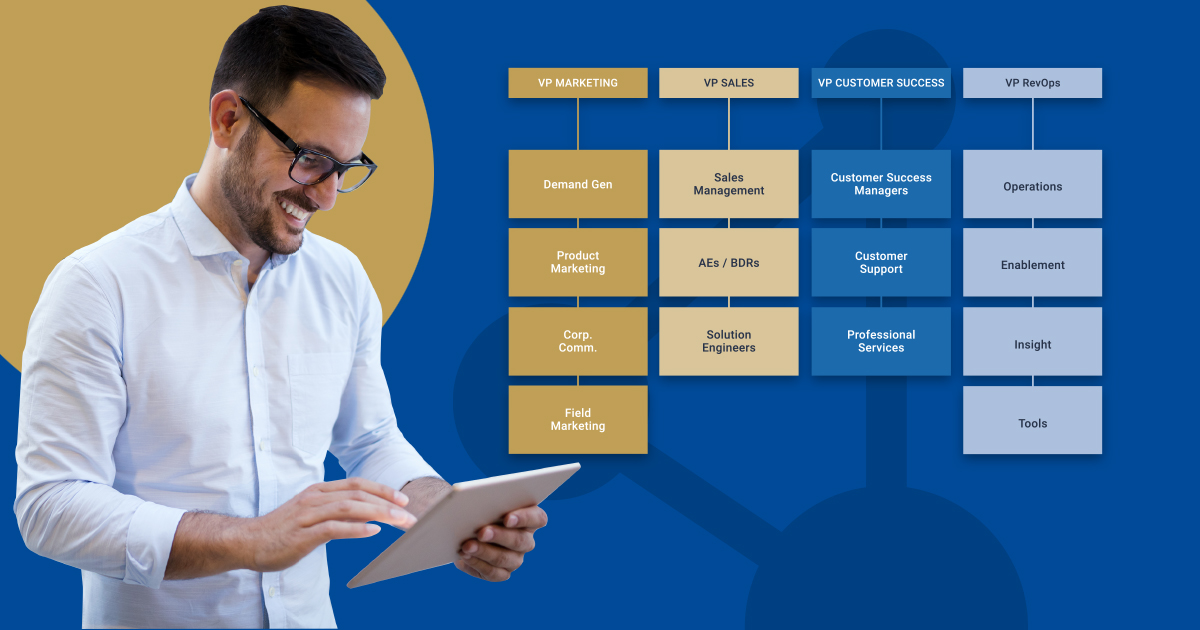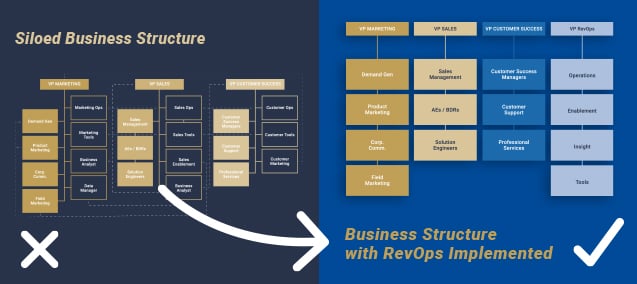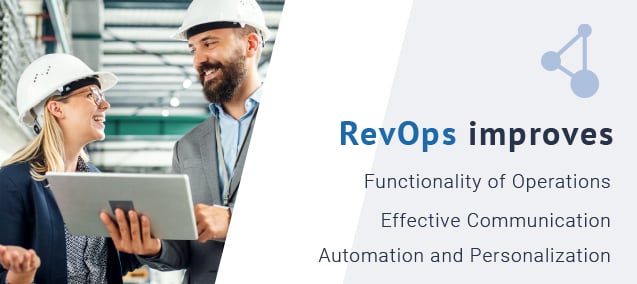
12 RevOps solutions you can use to improve your business operations
An in-depth guide of 12 actions you can take to implement Revenue Operations in your business. Including, How to audit your tech stack, focus on your customer's success, eliminate silos, automate your processes, monitor your analytics proactively and more!
What is Revenue Operations? (RevOps)
Revenue Operations aligns your Marketing, Sales and Customer Service departments to communicate effectively and work together as a collective.
The objective of Revenue Operations is to remove the silo mentality from your business and implement new processes that focus on sustainable revenue growth through productivity and operational efficiency.
 RevOps helps you align your technological systems, increase efficiency, analyse your operations, build a unified team of experts and provide a seamless customer experience. RevOps focuses on improving specific pain points to increase the amount of revenue generated, and holistically push your business towards scaled growth.
RevOps helps you align your technological systems, increase efficiency, analyse your operations, build a unified team of experts and provide a seamless customer experience. RevOps focuses on improving specific pain points to increase the amount of revenue generated, and holistically push your business towards scaled growth.
When’s the best time to start implementing Revenue Operations?
The most suitable time to implement the RevOps framework is when you want to increase efficiency, unify your operations, utilise your systems more effectively, or if you feel your business is not performing to the best of its capabilities. It is ideal to implement the RevOps mentality when you first start your business, as it will help you to build stronger workplace relationships and bring a centralised focus to your customer’s journey.

If you have an established business and want to improve on:
- Internal systems and operations
- Data management and analysis
- Employee relationships and communication
- Automatic processes and personalisation
- Increasing scaled growth
- Revenue generation, without incremental costs
- Unifying operations
- Improving customer satisfaction and customer referrals by using a customer centric approach
- Stimulating seamless integration
It’s the right time to start implementing RevOps.
 What RevOps solutions do you need?
What RevOps solutions do you need?
The solutions you need depend on how your business operates and what your specific pain points are. We know, there is no ‘one size fits all’ when you're solving problems for your business and this is equally true with RevOps. However, these 12 solutions can give insight into how you can begin to improve your business processes.
Our solutions will help your business build stronger relationships with customers through maximising efficiency with internal operations, elevate your customer experiences, advance your digital transformation methods, and help you execute seamless integration tactics.

12 RevOps solutions you can Implement, to Improve your Business Operations:
 1. Audit Your Tech Stack and Consolidate Systems.
1. Audit Your Tech Stack and Consolidate Systems.
Audit your current operations, and assess how effective your systems are at tracking data. Your aim with analytics, reporting, and managing data, should be to reach ‘a single source of truth’.
We find businesses will utilise a number of platforms to manage their operations. However, when each platform is maintained separately, it leads to overlaps in common data, and creates ‘multiple sources of truth’.
Frequent issues such as ambiguity in data integrity, and inefficiencies in data input can arise from utilising multiple platforms, without centralising data. When you have ‘multiple sources of truth’ there is no guarantee the data will be represented accurately across these multiple disparate systems.
To avoid gathering inaccurate data, develop a central customer database as the ‘single point of truth’. This allows you to utilise all of your current platforms and systems, and keep the data accurate, accessible, and unified.
To build a single point of truth system, you will need a Customer Relationship Management system (CRM). CRM systems consolidate all customer specific data, and only use other platforms for a specific purpose, such as an accounting system or industry specific platform. Once these systems have aligned, your customer information should be drawn from the central CRM, ensuring there is no data ambiguity and enabling a single point of data entry.
 2. Establish your Marketing and Sales ‘Flywheel’.
2. Establish your Marketing and Sales ‘Flywheel’.
The flywheel method shifts your focus towards sales and marketing activities that have the biggest impact on improving your business and increasing revenue. It is designed to remove unnecessary points of friction and help you seize opportunities that build momentum for your marketing and sales operations.
'Forces' you can apply to your business may include:
- Utilising a strong inbound marketing strategy
- Implementing a customer referral program
- Creating customer success teams, who are dedicated to delighting consumers at every stage of their customer journey
‘Friction’ points will slow your customer success rate down, disjoint your processes and affect your revenue streams. Removing ‘friction’ from the flywheel will improve its momentum and streamline your processes to be more efficient.
Innovative solutions for removing ‘friction’ may include:
- Removing poor or undocumented internal processes
- Removing silos in your organisational structure
- Removing bottlenecks in your sales process
- Eliminating manual inefficient processes with automation and personalisation
Customer referrals, and word-of-mouth, have become the largest influence on the purchase process. As you increase the speed of the flywheel, you will increase the number of customers that become promoters of your business. This ultimately adds to the size of the flywheel, increasing momentum even further.
We recommend implementing the flywheel model to build a powerful inbound marketing strategy and increase revenue growth.
 3. Focus On Your Customer’s Success.
3. Focus On Your Customer’s Success.
One of the key strategies in developing customers to become advocates for your business, is to take an empathetic approach to their needs, and business growth objectives. A customer service team that understands these important aspects, will be in a much better place to deliver solutions that the customer perceives as high value.
The process of attracting, engaging, and delighting customers, is a fundamental component of the ‘flywheel’ marketing and sales philosophy.
Focus on your customer experience, and deliver tailored solutions for their needs. Utilising thorough customer journey mapping, targeting specific markets and creating avatars, will help your business build stronger relationships with consumers.
Additionally, obtaining a strong focus on customer feedback, will enable you to solve problems as they arise, and prevent them from reoccurring in the future. To have a proactive approach, analyse your data regularly, and look for similarities with lost sales. If there is a common friction point at a particular stage in the flywheel, reassess your strategy and alter your processes to better suit your consumers.
As a business owner, you ultimately focus on achieving high customer satisfaction rates, and providing high-quality solutions for each and every customer. Enable your goals to become your centre focus, and build a business and RevOps team to compliment these objectives.
 4. Align Marketing, Sales and Operations.
4. Align Marketing, Sales and Operations.
Companies that are efficient, are companies that are profitable. Streamlining your business and constantly looking for efficiency improvements will ensure that you are always maximising your profitability.
To align your customer-facing teams and increase efficiency you can:
- Ensure all areas of the business are accessing the same single platform, and use accurate, ‘single source of truth’ data.
- Remove departmental silos, and encourage specialist areas of the business to work together as one powerhouse growth team.
- Document your procedures and policies.
- Have an agile and effective website.
- Use smart sales tools such as triggered task management, and automated workflows.
- Measure and track advertising.
- Use customised data dashboards that present data to staff in a meaningful, timely, and reliable way.
- Provide efficient and effective ways for the customer to interact with you using chatbots, ticket systems, knowledge centres, and 1:1 videos.
 5. Automate, Automate, Automate.
5. Automate, Automate, Automate.
One of the best practices to get consistency and achieve efficiencies in your service delivery, is to automate your operations as far as practicable. This eliminates inconsistent workflows and variations to service delivery, created by human resource biases. Revops automation must be tailored to your business’s specific needs to maximise efficiency.
You can implement automation to eliminate:
- Repeated tasks
- Manual labour
- Data entry
- Processes
- Monitoring data
- Emails
- Irrelevant campaigns
 6. Align Your Revenue Operations Strategy to Your Business Plan.
6. Align Your Revenue Operations Strategy to Your Business Plan.
Revenue Operations should align with your company goals, and work towards creating a unified culture that supports the direction your company is heading in. Revenue Operations aligns each department's goals to complement the overall strategy, including developing KPI’s, using metrics, and reporting methods. This analyses the sales success rate of each department and the functionality of your business operations.
The RevOps process allows you to continually monitor your progress, plan ahead, evaluate how efficient your operations are performing, and encourage you to document improvements that are made along the way.
Start by creating a written document that aligns your RevOps strategy and the company's goals. Outline what your focus should be and implement a plan of action. Ensure to document the steps you will take and which milestones signify your progress. Implement SMART objectives, (specific, measurable, achievable, relevant and time-bound) to ensure you illuminate the areas that matter most for increasing success in your business.
This documentation will help you evaluate the effectiveness of your RevOps strategy and identify clear areas that need improvements.

7. Monitor Analytics Proactively.
Establish trigger points in your data reporting that proactively advise you of a potential issue, to effectively analyse pertinent data.
It is extremely time-consuming and inefficient to comb through endless amounts of data to find what is or is not working in your business. You should only be alerted to the analytics that are a potential problem, to enable you to proactively solve issues before they arise.
Ultimately, using artificial intelligence powered analytics will enable you to have clear indications of your business's strengths and weaknesses. Fast-tracking your abilities to prevent, plan and predict issues or opportunities within the right timeframe.
AI-driven predictive analytics will move your business away from reactive strategies and help drive your business with accurate and detailed insights, and grow your business at a much faster rate. Over time, using AI and Machine Learning to monitor and analyse your data will enable you to have a clearer understanding of your business and how best to improve it.
Technology is ever-evolving, and businesses that use and quickly adapt to the most up-to-date strategies, have the best chance of outperforming their competition.

8. Consider Hiring a RevOps Manager.
Depending on your business needs, hiring a RevOps manager can advance your business operations and add benefit to your corporate culture. Having a RevOps champion in the business is a great way to ensure the RevOps culture becomes an integral component of your business strategy. They will understand your business thoroughly, and be able to work with each department on a regular basis. Helping to eliminate silos and gain insight for improving operations.
The alternative option is to outsource RevOps management, or individually implement RevOps strategies. Having an outside source look inwards, can lead to new idea generation, and RevOps specialists can gain a clear understanding of how to better your business, without being affected by certain paradigms. Outsourcing also eliminates the need to train staff, ensuring there is no drop in productivity or negative disruptions to the current culture of your company.
Implementing specific Revenue Operation strategies, can enhance your business processes and prepare your systems for scaled growth. Using automation to eliminate manual processes or manage your data more effectively, is a simple way to begin your RevOps journey and implement tailored solutions for your business. Although, seeking tailored and professional advice will have a much greater impact on gaining positive results.
 9. Actively Monitor Customer Feedback.
9. Actively Monitor Customer Feedback.
Develop strategies for your customers to provide honest and informative feedback. You could implement surveys, automated emails, monitor reviews and social media comments, or develop specific surveys to improve your offerings.
Use this feedback in a constructive manner, and analyse any shortcomings perceived by the client. This ensures you can be proactive in solving problems for your customers and create mitigation strategies to prevent issues from reoccurring.
As a business, feedback is one of your most valuable insights for improving your customer experience and monitoring your success rates with clients. Using this information can enable you to build stronger solutions for your customers, and tailor your experience to suit their needs. Whether that is improving products or services.
Within the HubSpot CRM, you are able to activate feedback strategies and tailor them to suit your needs. The CRM will track this information and enable you to monitor and assess your customer relationships over time, whilst ensuring you have accurate customer data and a single source of truth to rely on.
Remember to celebrate customer success stories with your staff, and ensure every customer that leaves a review is attended to. Ensure to save positive feedback to be used as testimonials, to help promote your business in the future.
 10. Ensure All Staff have Effective KPIs.
10. Ensure All Staff have Effective KPIs.
Key Performance Indicators (KPIs) allow you to track, monitor, and improve all of aspects your business operations.
Having specific goals in place will help guide your business in the direction you want it to head, and your KPIs should be curated to accurately help you achieve and monitor those goals.
Carefully analyse your staff’s KPIs to ensure they align with your RevOps Strategy and remove siloed objectives to compliment a unified corporate culture.
Ask yourself the following questions:
- Do my staff clearly understand their KPIs?
- Are the KPIs unambiguous and complementary?
- Are the KPIs documented and accessible?
- Do the KPI’s reflect the business’s RevOps strategy?
- Are the reporting formats for KPIs reliable, comprehensible, and consistent for all staff?
- Does raw KPI data come from a common trustworthy source?
If you find your KPIs are not aligned with your RevOps strategy, you will need to adjust your goals and objectives to suit both your business strategy and new RevOps methods.
 11. Keep up with the latest Technological Developments.
11. Keep up with the latest Technological Developments.
Technology is the single greatest tool for keeping your business competitive and efficient. Elevate your tech stack to complement your RevOps strategy, and ensure each specific platform communicates to the CRM to create centralised data.
Your ability to remain agile with your technology solutions will enable you to maintain an edge over your competition. Choose platforms that have a history of adapting to new technologies, such as HubSpot, Slack, or Xero, as these types of systems will keep you at the forefront of technological developments as they arise.
Keeping your data accurate, measurable and centralised will help your technology platforms work more efficiently and drive better results. Stay up to date with upcoming technology and regularly audit your current systems.
Technology shouldn't be something you implement once and forget about, to remain ahead of your competition, you must remain vigilant and regularly update your business with the best available resources.
 12. Remember the Importance of Your People.
12. Remember the Importance of Your People.
Take some time to consider your human resources. They are the single most valuable investment your business will ever make. Building a corporate culture your employees will thrive in and genuinely support is the best action you can take to ensure the longevity of your business.
Evaluate your current environment, and align RevOps to have a positive influence on your employees. The better your employees understand RevOps, the stronger the impact it will have.
Ask yourself the following questions:
- Do my staff reflect my company’s values?
- Is my business’s culture where I want it to be?
- Do my staff enjoy working in my business?
- Does everyone have a common sense of purpose in achieving the company’s RevOps goals?
- Do all my staff have a clear understanding of how their role contributes to the company’s success?
- Have I built career pathways for my staff, so that they can grow as the business grows?
- Do my teams work together as a cohesive unit?
Strengthening your revenue operations teams will enable you to grow and adapt to new environments. Growing your business to encourage specialists to work together, will increase the number of opportunities your business is exposed to. As your business shifts from a siloed mentality to operating as a collective, your processes and systems will become seamless. Having a strong corporate culture will enable you to grow with scale, and be prepared to overcome a diverse range of challenges.
Have you found the solutions listed in this article helpful?
Speak with our team to get a free Revenue Operations Review, and start improving your business strategy today.
Don't stop now. Keep learning
 What is HubSpot? A Complete Guide for Enterprise Businesses
If you’ve ever felt like your marketing, sales and service tools are scattered across too many...
What is HubSpot? A Complete Guide for Enterprise Businesses
If you’ve ever felt like your marketing, sales and service tools are scattered across too many...
 How to clean data in Excel before Switching CRMs
Excel can be a powerful tool for cleaning data before migrating to a CRM system. Many businesses...
How to clean data in Excel before Switching CRMs
Excel can be a powerful tool for cleaning data before migrating to a CRM system. Many businesses...
 WordPress vs Content Hub (HubSpot)
How to pick the right platform for your business: Both WordPress and Content Hub are powerful...
WordPress vs Content Hub (HubSpot)
How to pick the right platform for your business: Both WordPress and Content Hub are powerful...


